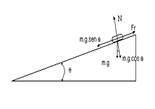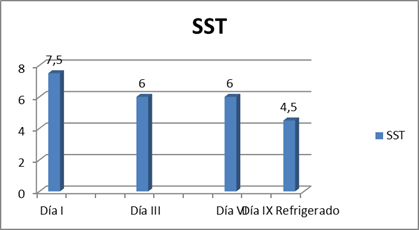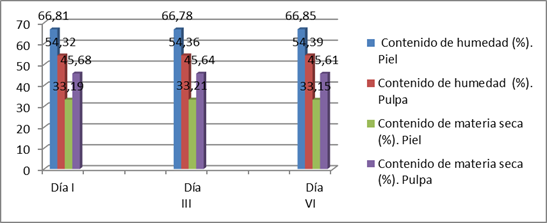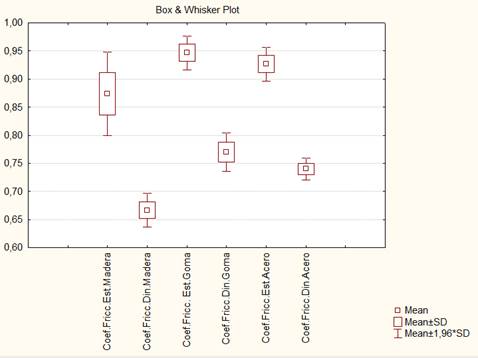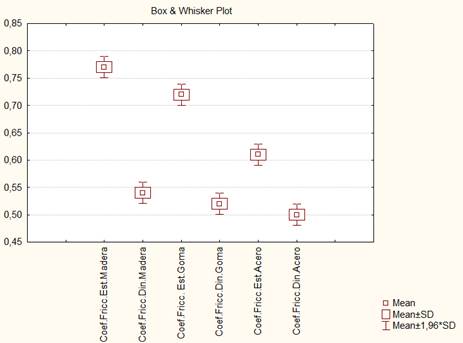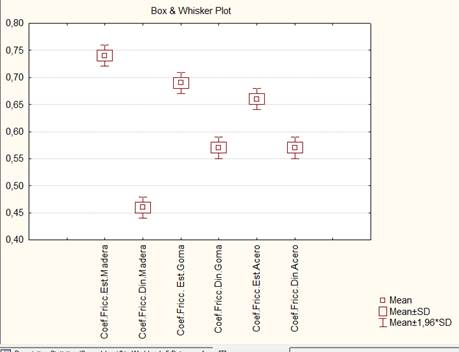INTRODUCTION
Cassava is native of tropical America, before 1600. Their scientific name is (Manihot esculenta Crantz) also well-known as manioc, casava or casaba, it is a perennial bush of the family of the euphorbiaceous, autochthonous and widely cultivated in South Africa and the Pacific for its starch root of high alimentary value. Cassava is endemic of the subtropical region of Bolivia, Brazil, Argentina, Peru, Ecuador and Paraguay although it is considered that the varieties known today are the result of the artificial selection. Nowadays, cassava is extended in almost the whole tropical region of the world (Cevallos, 2002). Today, cassava is cultivated in 92 countries where it feeds more than 500 million people. Cassava (Manihot esculenta Crantz) is a kind of an amylaceous root that is cultivated in the tropics and sub-tropics, although it is one of the most important nutritious cultivations in the tropical countries, outside of them it is not very well-known. Cassava, as other farinaceous cultivations, is used for human and animal feeding and, in both cases, it is consumed in diverse forms like fresh and dried. It can be processed to obtain flour or pellets. More than 100 by-products of natural food or ingredients for breads and substances used in pharmaceutical industry can be obtained from cassava. It is very well-known that the studies related with the physical - mechanical and chemical properties of the agricultural products can report important information to the postharvest as optimum moment for the harvest, susceptibility to mechanical damages, storage life and organoleptic qualities, among others.
However, there are not plentiful investigation in cassava in this field. Nevertheless, certain authors (Adetan et al., 2003; Brito, 2017 and García et al., 2017) have reported investigations in some of these topics. On the other hand, it is known that in the sphere of Agricultural Engineering, these elements constitute the primary data bases for the design and machinery construction related with the crop, manipulation, container, transport, storage and marketing of agricultural productions.
For this reason, the general objective of this work is to evaluate some of the physical - mechanical and chemical parameters of cassava (Manihot esculenta Crantz) for an optimum postharvest management of the product.
METHODS
Methodology to Determine the Sample Size
The sample size was calculated using the student approach, reported by Carballo & Prado (1980) for each investigated component. A pre-experiment was carried out with 15 cassavas taken at random in the field (private producer) and they were subdivided in subgroups of 3. These samples were monitored in the days 1, 3, and 6 after harvesting, to observe the development and evolution of the root from its harvest until its senescence state. Besides, the tests of its physical, mechanical and chemical properties were performed in each development stage. A subgroup of the sample was placed inside a refrigerator, Haier brand, model HRF 25, during 6 days, to compare the changes that happen in the tubers in a controlled atmosphere of 4°C, with those kept in normal conditions of pressure, humidity and temperature. These investigations were carried out in the Bromatology Laboratory of Universidad Central “Marta Abreu”, Las Villas. The sample size was calculated for a mean error smaller than 5% and in a level of significance of 0.10.
Methodology to Determine the Development of the Tubers
For the determination of the tuber development, the different stages its progress were monitored, observing the interval of time since the formation of the floral bud, starting with the differentiation of the cone of growth, until the maturation of the fruit. Besides, bibliography related to the study topic was consulted and interviews to technicians, workers, engineers and personnel qualified in the branch were done.
Methodology to Determine the Main Physical-Mechanical Characteristics in Tubers
These analyses were developed in the Laboratory of Bromatology, in the Center of Agricultural Investigations (CIAP) of Universidad Central “Marta Abreu”, Las Villas.
The methodology to determine the characteristics of cassava was that referred by Martinez (2012). The following determinations were done.
Determination of the longitude of the tuber
It was determined by measuring with a metric tape from the distal end until the proximal end, where it is considered the pulp finishes.
Determination of the tuber circumference
The circumference of the tuber was determined by measuring the cassava with a metric tape in its widest point.
Determination of the thickness of the peel and the pulp
After cutting traversely in the central point, the tuber was peeled and the peel and the pulp were measured separately with a precision Vernier caliper. The sensibility (precision) of the instrument was of 0.01 mm.
Determination of the relationship pulp/peel
The pulp and the peel were separated and weighed individually. The relationship pulp/peel is calculated by dividing the weight of the pulp by the weight of the peel). For this a Ferton scale was used, with a precision of 0.0001 g.
Determination of the static and dynamic friction coefficients
The coefficients of friction were determined with the use of an apparatus that carries an inclined plane, which allows variations of inclination and a scale that facilitates to carry out readings from the angle to which is inclined the surface. Figure 1 shows a sample of free body on this device.
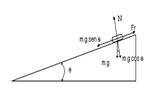
FIGURE 1.
Apparatus and free body for the determination of friction coefficient. Source: file of the author.
Applying Newton second law:
The static coefficient of friction was measured in the moment in that the body breaks the movement and therefore:
Starting from the equation (2) and knowing that:
Then:
To determine the dynamic coefficient, the same procedure was applied, but, in this case, a superficial impact was caused to the tuber to break the inertia.
Finally, by means of Equation (4), this indicator is determined.
This coefficient was determined before different surfaces such as:
Methodology for the determination of the total soluble solids (SST)
It was determined according to the Cuban norm (NC-ISO: 2173-01, 2002).
Methodology for the determination of pH
It was determined according to the Cuban norm (NC-ISO: 1842-01, 2002).
Mensuration of dry matter content and ash
It was determined according to the Cuban NRAG-103:1979 (1980); NRAG-105:1979 (1980).
Methodology to determine the mechanical damages
It was determined according to Martinez (2012), through the following protocol:
A manual instrument, which carries a graduate scale from the floor until their maximum height (1.20 m), varying in 0.15 m, allowed falling in free fall the selected tubers, with well-known averages masses (194 g, 208.5 g and 276 g), from a selected height similar to 1.20 m, on steel surface (the rubber surfaces and wood were not used for this test). The biggest height was selected, to simulate the maximum damage that could be infringed to the tuber, using this device. On the other hand, the manipulation of this product in the rammer and placement of the product in the means of transport occurs in heights similar and superior to this range. The masses of the valued tubers were selected keeping in mind the mean behavior of the samples investigated in this indicator. In all cases, it was allowed lapsing 48 hours after the provoking impacts and the parameters that characterize the mechanical damages for impacts were calculated.
Methodology to estimate the starch
It was determined according to Toro & Caña (1983). They took three fresh roots of cassava per variety or lot (approximately 3 kg), preferably recently harvested, of different sizes and thicknesses. The roots were cleaned with the upper part of a knife and the stuck earth, the root and the peduncle were retired
Once registered the weight of the roots in the air and in the water, the specific gravity was calculated using the following formula:
Where:
GE
- Specific gravity;
PFRAI
- Fresh weigh of the roots in the air;
PFRAG
- Fresh weigh of the roots in the water.
Since the content of starch in fresh roots of cassava constitutes around 85-90% of the dry matter content (MS), the content of starch can be estimated by taking an average of this range (0.875) and using the following formula:
Methodology for the physiologic deterioration
A group of 10 cassava roots were selected with a minimum size of 18 cm, without mechanical damages and without pre-harvest deterioration. Distal and proximal the extremes of the roots were discarded by cutting them with a knife, so that the root section to evaluate was approximately 15 cm long (Aristizábal et al., 2007). Then, the distal side was covered with a piece of PVC (plastic piece of polyvinyl chloride) to maintain the humidity and to avoid that the physiologic deterioration began from this surface and this way it will be developed only from the proximal end. This way the deterioration will only be developed from the proximal end. Later on the roots were stored in a place protected from the sun and the rain, but exposed outdoors (Bromatology Lab). They were evaluated after three days of storage. To avoid the microbial contamination, the roots were transversely cut in sections at the 2, 4, 6, 8, 10, 12 and 14 cm starting from the proximal end. A total of seven sections were obtained. 3 roots of each treatment or variety was evaluated to obtain the average of the grand total of the values of the seven evaluated traverse sections.
The percentage of deterioration was determined using the following expression:
Methodology for the cooking tests
In the field, 3 cassavas were taken at random (1 kg), they were peeled and 1.5L of water was added at room temperature. They began to boil in an electric burner during 30 minutes, later that water is discarded and it is returned to add the same quantity of water to ambient temperature and it was allowed boiling 30 minutes more. This experiment had like object to determine the specific energy consumption kW-h.kg-1 of cooked cassava. This characteristic has been studied in cooking bananas for Dadzie & Orchard (1997), but similar studies are not known in cassava, consequently, this investigation could contribute information in this field, such as: easiness of peeled, stability of the pulp before and after boiling it, adsorption of water by the pulp and duration of the cooking or boiling. In this case, the duration of the cooking and their specific consumption of energy were observed.
Methodology for the prosecution and statistical analysis of the data
The obtained data of the readings of each established variables were tabulated by means of the electronic tabulator Microsoft Excel. For the data processing the statistical package Statistica 8.0 was used. Procedures of comparisons of descriptive statistics, statistical summaries, charts of frequency, and histograms in all the variables and valued treatments were applied.
RESULTS AND DISCUSSION
Sample size
According to Carballo & Prado (1980), the sample size for the impact tests was determine and it was of 15 roots (cassava), while for the determination of the physical-mechanical and chemical properties for the laboratory analyses the sample size took three samples (triplicate), in accordance with the protocols of the Bromatology Lab in Center of Agricultural Investigations (CIAP) of Universidad Central “Marta Abreu”.
Obtained results related with the development of the tubers
As Gomez et al. (1983) referred, the evolution of the tuber demands approximately several weeks (36). When the development of the tuber has finished the plant begins to lose part of its leaves. In our case, the investigated roots were taken in the good moment for the crop, in the second week of January, 2017 (38 weeks).
Main physical-mechanical characteristics
In Table 1 the results of the physical-mechanical characteristics evaluated in the roots (cassava) studied (variety Jagüey dulce) are presented.
TABLE 1.
Physical-mechanical characteristics obtained. Source: Own elaboration
| Valued parameter | Minimum value | Maximum value | Mean value |
|---|---|---|---|
| Longitude (cm) | 22 | 33 | 27.5 |
| Circumference (cm) | 15 | 17 | 16 |
| Thickness of the peel (mm) | 2 | 4 | 3 |
| Thickness of the pulp (mm) | 46 | 54 | 50 |
| Relationship pulp/peel | 4.5 | 5 | 4.75 |
From the analysis of the previous table, it can be observed that the longitude presents a mean value similar to 27.5 cm; the circumference a mean a value of 16 cm; the thickness of the peel a value of 3 mm; the thickness of the pulp a value of 50 mm and the relationship pulp/peel a coefficient of 4.75. These indicators are inside the ranges of other varieties of existent cassava in the country.
Tests of friction: The friction tests were made in tubers immediately after harvesting (Table 2). The friction coefficients in rubber surface were the biggest values obtained, followed by the ones in steel surface, while in wooden surface the values dropped. The former is an expected result, but not the latest, due to the higher roughness of wood respect to steel.
TABLE 2.
Results of the friction coefficients. Source: Own elaboration
Total soluble solids
The obtained results referred to the total soluble solids (SST), are shown in Figure 1. In this case, the biggest values were presented in the tubers with a later day to the crop. It was diminishing progressively in the third and sixth days after harvesting. In the case of the refrigerated sample, this value went down significantly with regard to the first later day to the crop. That indicates that it could be influenced by the acidification of the cassava roots; for what would be interesting to deepen in this indicator in future investigations. In studies made by Scott (2002), this indicator was not analyzed.

FIGURE 1.
Evolution of the total soluble solids (SST) in the investigated roots. Source: Own elaboration.
pH
The obtained results referred to the pH, are presented in Figure 2. In this case, in the first day of harvested the samples possess a value next to neuter (7.15), while in the third day after harvesting the highest value was presented (7.2). On in the sixth day, a small falling took place (7,03), while in the refrigerated sample, the pH drop was presented (6.96), which indicated an acidification process. These results are referred to cassava roots and not to the starch. The pH in the native starch should be between 6.0 and 6.5 (ISI, 1999).
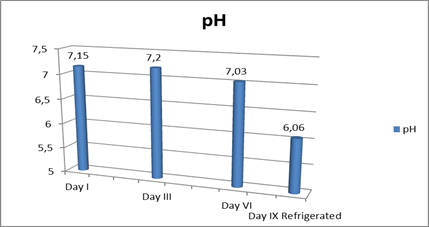
FIGURE 2.
Evolution of the pH. Source: Own elaboration.
Humidity of the peel, the pulp and the dry matter content
Results are shown in Figure 3. In this case, the content of humidity in the peel remained constant during the period analyzed with values next to 67%, while the dry matter content values were on 33%. The content of humidity in the pulp was 54% and the dry matter content in the pulp oscillates in values next to 46%. However, in investigations made by Llanos & Buitrago (2002), dry matter content in fresh roots were between 20 and 45%, next to the results obtained in this work. While in the content of humidity the values obtained by these authors oscillate between 55 and 80%, which coincides with the results obtained in this work.

FIGURE 3.
Humidity content and dry matter content of the peel and the pulp. Source: Own elaboration.
Mechanical damages
These analyses were carried out immediately after harvesting the roots evaluated (Tables 3 and 4). Roots were dropped from a height of 1.05 m and 1.20 m, with impact energy that oscillated between a minimum of 2037.72 (J) and a maximum of 3245.76 (J). These heights were valued to obtain a frontier of the maximum possible damage caused to the roots using the available instrument in this investigation.
Results presented in Tables 4 and 5, show the behavior of the damages for impact of dropping tubers from different heights (1.05 - 1.20 m) on steel surfaces. It can be appreciated that, as the height increases, the impact energy increases, presenting the root a bigger susceptibility to the damages provoked, mainly to those induced in the steel surface with impact energy similar to 3245.76, with a susceptibility of 3.9. They were the values obtained for the biggest height of the tuber falling, affecting this way, not only the surface of the cassava, but also its pulp. As it was said in Materials and Methods these tests were carried out with different impact energy. According to Martínez (2012), the mechanical damages are one of the main factors in post harvesting deterioration of agricultural products. It also affects the low quality of marketing and prices, and because of that, it is very important to minimize the possible damages caused in the manipulation of the product.
TABLE 3.
Results of the impact damages in the tubers dropped from 1.05 m of height Source: Own elaboration
| Height (m) | Mass (g) | Impact energy (J) | Susceptibility | Area of the contusion (cm²) | Volume of the contusion (cm³) |
|---|---|---|---|---|---|
| 1.05 | 18 | 2037.72 | 0.14 | 6.36 | 28.61 |
| 1.05 | 205.13 | 2110.78 | 0.18 | 7.90 | 39.25 |
| 1.05 | 284 | 2922.36 | 0.45 | 17.6 | 132.46 |
TABLE 4.
Results of the impact damages in tubers dropped from 1.20 m of height Source: Own elaboration
Estimate of Starch
The results obtained while estimating starch in cassava were of 47.56%, however, in investigations carried out by Toro & Caña (1983), these values oscillated between 17.5% and 39.4%, which indicates that the variety analyzed in this work presents significant difference with regard to those evaluated by Toro & Caña (1983). That could be given by the different climate conditions in both countries; as well as for the different cassava clones evaluated.
Physiologic deterioration
The results obtained in the physiologic deterioration three days after harvesting the tuber were of 20.4%. That indicates an express deterioration of the tuber at environmental conditions, due to that the importance of a careful handling and conservation of the tuber. Wheatley (1983), reported that the physiologic deterioration in cassava varies from 0% to 100%, depending on the age of the cultivation at the moment of the harvesting, as well as on the climate condition in which the plants grow. Storage conditions have also to be considered due to cassava little warehouse life (shelf) as Wheatley (1983) & Thompson (1998) referred.
Cooking tests
Cooking tests demonstrated that the variety of cassava "sweet Jagüey" presented a total softening, it is ready for the consumption in one hour, with an energy consumption of 1 KW-h.kg-1 of cooked cassava. This indicator showed that in this time period, the pulp is cooked well, remains shaped and not watery. This indicator could be used as reference for other cultivated varieties of cassava in Cuba.
Statistical Analysis
Statistical analysis of the static and dynamic friction coefficients was carried out by means of the professional package Statistica, 8.

FIGURE 4.
Results of the calculation of static and dynamic friction coefficients by means of statistical analysis Box and Whisker Plot in cassava with 1 day of harvested. Source: Own elaboration.
In Figure 4, it could be appreciated that the maximum values of the static coefficients of friction were presented in the rubber surface, followed by the values obtained in the wooden surface and culminating in the steel surface, with the lowest values. That is a prospective result, keeping in mind the grade of superficial ruggedness of these surfaces. In the dynamic coefficients of friction the biggest value coincides with the rubber surface, however, in the second place the values obtained in the steel surface appeared. It could be given by the same phenomenon described in the static coefficients of friction, but in an opposite way.
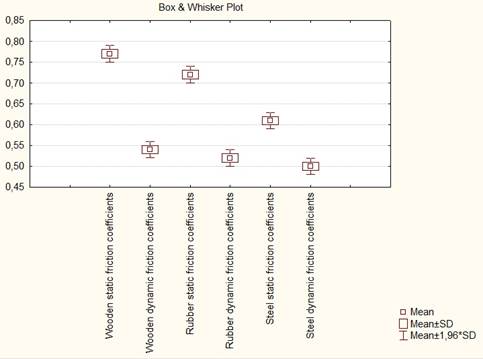
FIGURE 5.
Results of the calculation of static and dynamic friction coefficients by means of statistical analysis Box and Whisker Plot in cassava with 3 days of harvested. Source: Own elaboration.
In Figure 5, it could be appreciated that the maximum values of the static coefficients of friction were presented in the wooden surface, continued by the values obtained in the rubber surface and culminating with those obtained for the steel surface as the lowest. That is a prospective result, keeping in mind the grade of superficial ruggedness of these surfaces. However, in the coefficients of dynamic friction the same effect was presented, but in this case the values obtained in both coefficients diminished with regard to the first day (Fig. 4), which could be given by the grade of deterioration of the cassava skin or peel.
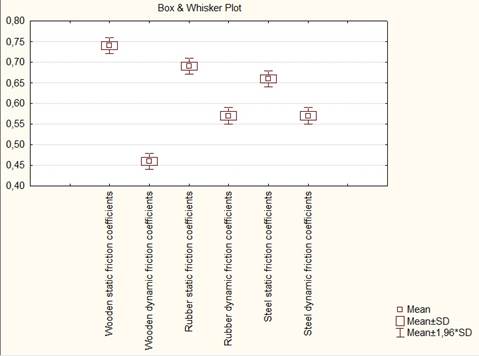
FIGURE 6.
Results of the calculation of static and dynamic friction coefficients by means of statistical analysis Box and Whisker Plot in cassava with 6 days of harvested. Source: Own elaboration.
In Figure 6, it could be appreciated that the maximum values of the static coefficients of friction were presented in the wooden surface, continued by the values obtained in the rubber surface, culminating in the steel surface, with the lowest value, which is a prospective result, keeping in mind the grade of superficial ruggedness of these surfaces. However, in the coefficients of dynamics friction a contradiction was presented when a counter-effect appeared in the wooden and similar in the rubber and steel surface, having as a constant that, the values obtained in both coefficients of friction diminished with regard to the third day (Fig. 5). That could be given by the grade of deterioration of the cassava skin or peel. These results differ significantly from the ones obtained by García et al. (2017), who obtained values of the static friction coefficient for two cassava varieties (Reyna and Paigua Negra) without bark in contact with the steel, between 0.41 and 0.39. Aristizábal et al. (2007), found values that oscillate between 0.30 and 0.65, according to different surfaces of friction, but referred to peeled cassava. On the other hand, other investigators have studied another physical-mechanical characteristics of cassava such as percentage in weight of the skin or peel, thickness of the peel, diameter of the roots, hardness (penetration force), determining different correlations among these variables (Adetan et al., 2003), some of which have not been study object in this work.
CONCLUSIONS
The influence of the climatic variables in the physical-mechanical and chemical properties for the samples of tubers monitored 1, 3 and 6 days after harvesting showed the following results:
The pH, showed few significant changes on days after harvesting.
The variable total soluble solids (SST) did not present differences among the analyzed samples the third and sixth days after harvesting, but it had differences deal with the first day without refrigeration and the first refrigerated day.
The tests of impact of the order from 2037.72 (J) to 3245.76 with susceptibilities of the order of 0.14 and 3.9, reaffirmed the delicacy of these tubers to mechanical damages, which together to their little shelf life (3 days), confirmed the importance of an appropriate postharvest manage of this tuber.

